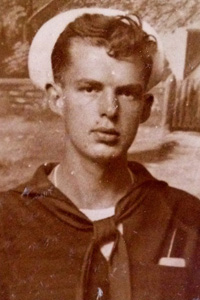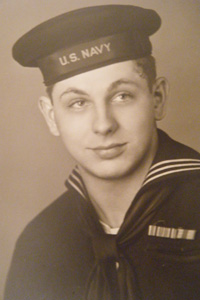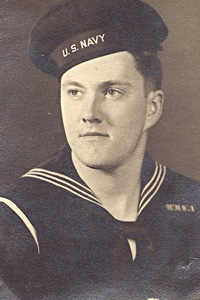Veterans recall D-day, June 6, 1944
By David Zucchino
It was the largest amphibious invasion in history: More than 4,000 ships, 11,000 warplanes and 156,000 Allied troops attacked five beaches in Normandy on June 6, 1944.
“Today we tend to think victory on D-day was inevitable. It was anything but,” said Keith Huxen, senior director of research and history at the National World War II Museum in New Orleans.
Operation Overlord gave the Allies a foothold in France, at the cost of more than 4,400 Allied dead on June 6. But what if it had failed?
“The Hitler regime would have survived,” Huxen said. “He would have rebuilt his forces and attacked in the future. War would have found us again, and probably in a weakened condition. D-day was the day we absolutely had to win.”
Donald Englar, 88

Donald Englar saw his best friend cut in half by an artillery shell as he stood beside him on a landing craft. Seaman 1st Class Robert DeLuca, a gunner, was blown into the water, lost forever.
Englar was 18 years old, a coxswain who operated a 36-foot Higgins boat delivering troops in the first assault.
Some of the men Englar was transporting were killed by German gunfire while in the boat. Others died on their way down the landing ramp, and still others in the pounding surf.
Of the 33 men in the boat, Englar said, only six survived that first landing.
“I saw so many terrible, terrible things that day,” he said.
Englar made five landings that day, ferrying soldiers from a troop ship 12 miles off the beach. Of the 22 Higgins boats launched from the ship, he said, only 10 survived.
He remembers joking to the men that he’d try to deliver them close enough to the beach so they wouldn’t get their boots wet. But sometimes he hit sandbars and the soldiers went into water over their heads. Sometimes he got them to knee-deep surf. And sometimes, he had to maneuver the 10-foot-wide boat around burning Higgins boats and bodies of soldiers.
On his fifth return trip, loaded with at least a dozen wounded men, Englar’s boat took a direct hit, probably from an artillery shell. Englar’s ramp man was badly wounded and Englar knocked unconscious, left bleeding from shrapnel and burned on his face and hands.
“A big crack and a flash is all I remember,” he said.
He said he regained consciousness in time to take control of the damaged boat and make his way to a troop ship.
For decades afterward, Englar never spoke of D-day. “I didn’t want to even think about, much less talk about it,” he said. But it came back to him in dreams.
But about a decade ago, Englar learned that a French family had recovered part of DeLuca’s remains on a Normandy beach about two weeks after D-day. The remains were buried at the Normandy American Cemetery.
Englar later visited Normandy, found the grave site and said goodbye to his friend.
Cosmo Uttero, 90

He hit the water and went straight down — his rifle, shovel, gas mask, rations and gear so heavy that he sank like a brick. He feared he would drown.
“I jettisoned everything. I mean, I just unhooked it and let it go,” Uttero said, recalling his first steps off a lurching landing craft at Omaha Beach.
He was 20 years old, with no combat experience, and he was terribly seasick. Many of his buddies in the landing craft were sick too and vomiting. It was noon, several hours after the invasion had begun.
“It wasn’t until then that the realization hit me how awful it was. I didn’t know what it was like to die,” he said.
Uttero said he made his way to shore and picked up a rifle from a dead American soldier. He couldn’t fight his away over the cliffs straight ahead, so he moved down the beach to his right. He couldn’t find anyone from his unit.
“Men were dying and dead everywhere,” he recalled.
He took cover in the bluffs in either a house or a bunker — he can’t remember. “It’s embarrassing” he said. “I should remember more.”
His memory is flecked with what he calls “snapshots” — a dead American paratrooper dangling from a tree, the taut faces of German soldiers, a truck engulfed in flames. And he remembers looking down from the bluffs at all the burning tanks and dead Americans stretched along the beach below.
That first night, he took cover with a couple of men from his company who had stumbled upon him. He doesn’t remember their names.
“It was so quiet — I do remember that,” he said. “I didn’t hear any hollering or crying from the men. Nothing.”
Uttero said he was one of just three men in his company who weren’t killed or wounded. He went on to fight more battles in France, sleeping in hedgerows as Allied forces slowly pushed the Germans back. Later that year, he spotted a German girl while searching a house in Germany. He saw her again later, riding a bicycle with her sister. He married her in 1948.
He will mark the anniversary in Normandy — his first time back — on a trip paid for by the National World War II Museum. His daughter and granddaughter, who serves in the Navy, are with him.
“I don’t know what to expect. I know it’ll be very emotional,” he said. “I have angina, so I know I need to keep calm and not get too excited.”
He wants to find the spot where he came ashore and the place in the bluffs where he took shelter. He hopes the visit will fill in the details of those snapshots of memory.
He’ll visit the Normandy American Cemetery. He wants to look on the headstones for the names of the men he knew from so long ago.
Charles “Buster” Shaeff, 88

When the first waves of American troops pushed ashore to begin the invasion on Omaha Beach, Buster Shaeff was right there on the shoreline at Pointe du Hoc.
Shaeff was a crewman on a Higgins boat, a 36-foot landing craft that ferried soldiers from a troop ship 10 miles off shore. He helped deliver nearly three dozen crack U.S. Army Rangers to the beachhead, then returned through treacherous waters to collect more troops from the main ship.
He was a confident kid from Norristown, Pa., who had joined the Navy at 17 with his parents’ permission. “I wasn’t too apprehensive going in,” Shaeff recalled. “I was an 18-year-old kid and I figured nothing would happen to me. You think, if it happens, it’ll happen to someone else.”
After crossing the English Channel that morning, Shaeff was aboard an LST — “landing ship, tank,” which soldiers called a “long slow target.” But then he transferred onto the smaller Higgins, the boxy boats famous for the ramps they lowered to let troops ashore. He made three round trips through choppy seas. Miraculously, there were no casualties on his boat.
Shaeff wasn’t supposed to go ashore, but he ended up on the beach about 9 p.m., on his third trip delivering troops. The boat struck a hedgehog, a metal fortification placed by Germans to block Allied ships. The leaking boat was able to limp ashore but was no longer seaworthy.
The hedgehog did not contain a mine. “If it had, I wouldn’t be talking to you,” Shaeff said.
Soldiers from the 29th Infantry Division were delivered ashore as planned, but Shaeff and his fellow crewmen had to take cover on the beach until they could catch a ride back on a different Higgins boat.
Each round trip took six to seven hours through the turbulent English Channel, and no one slept. The shelling and gunfire seemed incessant.
Shaeff managed to avoid being hit by enemy fire on D-day, as well as on the subsequent days he spent on Omaha Beach and in the months that he helped ferry troops and equipment from southern England to the Normandy coast.
He had a vague sense then that he had played a small role in a massive undertaking. Just seeing the armada of ships and all the planes overhead told him that much.
But for years after he left the Navy in March 1946, Shaeff never talked about the war. He didn’t open up until after the National D-day Memorial was established in 2001 in Bedford, Va., not far from his home in Lynchburg. Bedford, population 3,200 in 1944, lost 19 men on D-day. The city said it was the greatest loss, per capita, of any community in the United States.
Only after spending time at the memorial did Shaeff finally comprehend the full implication of what he and thousands of other service members had accomplished.
“I finally realized,” he said, “that this was a momentous event.”
Carter Fisher, 89

Carter Fisher’s job the morning of D-day was to help hoist massive shells for the 12-inch guns aboard the battleship Arkansas a mile off the coast of Normandy.
Fisher was 19, stationed inside the turret on Battery One. Shortly after 5:30 a.m., the Arkansas began pounding German positions on the coast in advance of the Allied beach assault.
All day long and into the evening, the battleship moved up and down the coast, firing its big guns. Fisher didn’t see much because he was in the turret, but he heard the blast of the naval guns and the firing of antiaircraft artillery.
Two German fighter planes attacked the Arkansas that evening, he recalled, and both were shot out of the sky. He never knew whether the Arkansas’ guns, or firing from other U.S. ships nearby, destroyed the planes.
It was a fortunate day for the Arkansas. The battleship took no casualties, Fisher said.
“We felt pretty lucky because we knew what the guys on shore were going through,” he said.
Fisher left the Navy in 1946 and never talked about the war, even though he had taken part in three other Allied invasions in southern France and the Pacific.
He started sharing his memories only after he volunteered to become a guide at the D-day Memorial that opened in 2001 in Bedford, Va., not far from his home in Roanoke.
“I don’t brag about it, but I’m proud to tell people I served there,” he said.
His most important instruction to visitors, he said, was to take special note of the 4,413 names (2,499 Americans) engraved at the memorial, representing the Allied dead from D-day.
Fisher didn’t know any of those men, he said, “but it’s important for people to remember every one of them. Those are the ones who didn’t come back.”
Credits: Written by David Zucchino | Produced by Evan Wagstaff